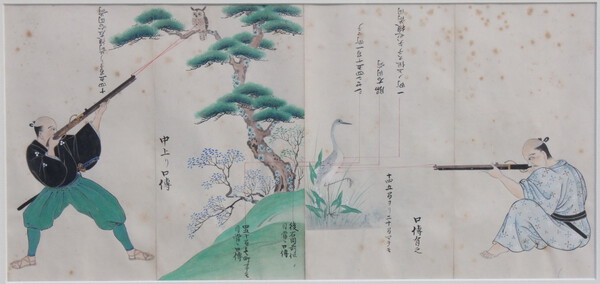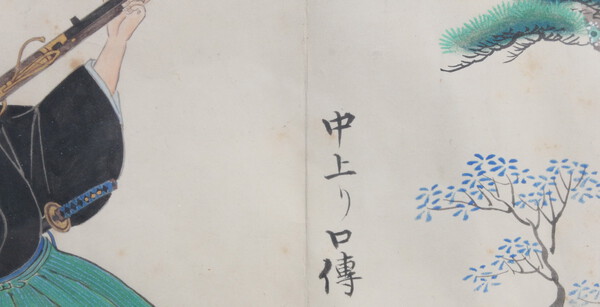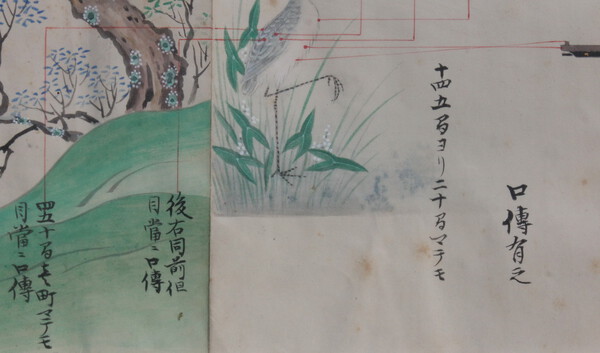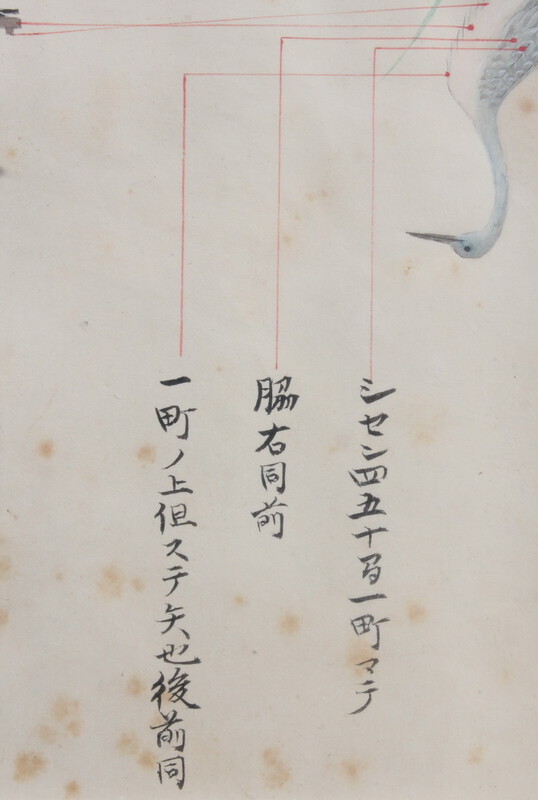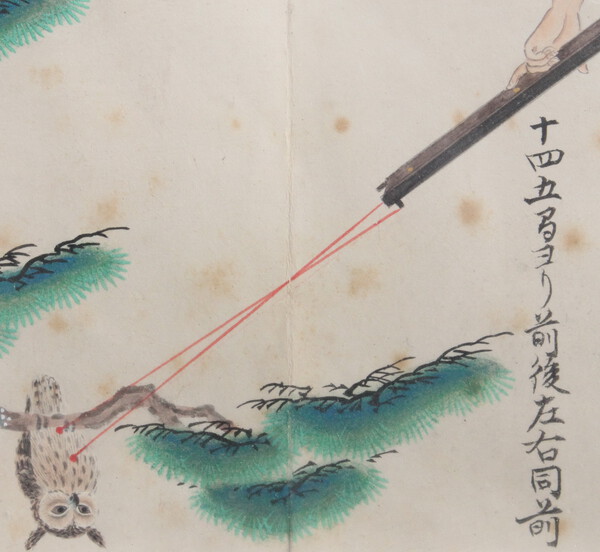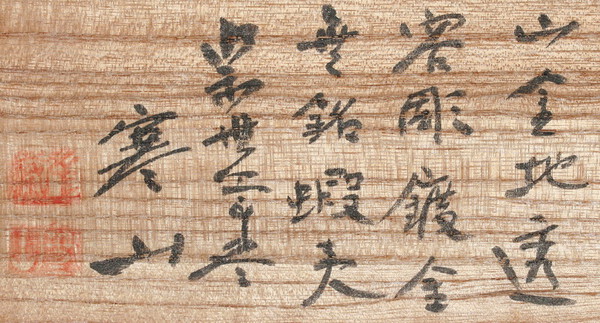-
Posts
2,743 -
Joined
-
Last visited
-
Days Won
27
Content Type
Profiles
Forums
Events
Store
Downloads
Gallery
Everything posted by Bazza
-

Woodblock print with matchlocks!
Bazza replied to Viper6924's topic in Tanegashima / Teppo / Hinawajū
Well, this isn't a print, but appears to be a one-off original painting. It came "out of the blue" from a local auction in what appears to be a modern (i.e., recent) framing. It features two hunters with line-of-sight points on birds and other lines from parts of the bodies to explanatory notes. The work is 41cm x 19cm. A curious feature to me is that the text at the top of the work is upside down. It appears to be two separate images joined together before the red lines were drawn, then folded into four as in a "brochure" style. I'm wildly guessing this is Meiji period because of the bright green colours (aniline dyes??) and of course the foxing indicates age, but what?? I note the presence of numbers and katakana but have not done any work on translation. I put it here for interest re the matchlocks and if anyone cares to translate the text i'm sure we will all be the wiser. Anyway, FWIW here are some images. Bestests, BaZZa. -

One of my latest aquisition - your thoughts are welcome!
Bazza replied to Thierry BERNARD's topic in Tosogu
Ahh, yes, but that's an old NBTHK Tokubetsu Kicho. Do we believe them without a more recent submission to NBTHK or either of the NTHKs???!!!! BaZZa. -

One of my latest aquisition - your thoughts are welcome!
Bazza replied to Thierry BERNARD's topic in Tosogu
Hmmmmmmm - my thoughts will probably see me at the end of a plank with a kissaki in my back!!!! A very nice piece. I love it to bits. Kevin Adams??? BaZZa. -
Ahhhhhh, even worse, they could be/most often are "yesterday" Chinese copies... BaZZa.
-
I do believe the slots where the vines are inlaid can be seen where the tendrils intersect the body of the tsuba. That's how it appears to me. Regards, BaZZa.
-
We all know this is a katakiriha sugata (shape). I've had as good a look at the photos as possible for the condition, and I just raise the point could this more likely be a Shinshinto Kaifu blade??? BaZZa.
-
Dear Ford and Listeros, A friend here has a Takahashi Naganobu katana with a fascinating koshirae. The question here concerns the metal working technique for the en suite fuchigashira and kojiri. I do not recall seeing anything like this technique in all my decades of collecting and study, but I'm sure someone on this magnificent board does. I'm tempted to say ishime, but it is far too complex for that IMHO. Below are some photos of the tsuka showing fuchigashira, a closeup of the fuchi and a closeup of the fuchimei. The metal appears to be shibuichi, given the silver appearance with the suaka visible through wear. If anyone is able to identify the artisan and make comment on where this work fits into the tosogu schema I would be very grateful - and so would my friend. Best regards, BaZZa.
-
Dear Ffolke, On top of the success of Ford Hallam and Andrew Ickeringill in Japanese sword arts contests, non-Japanese are also excelling in Yabusame. I must say this was real news to me AND the link sent to me by a mate who has little interest in things Japanese, but knows my passion. Check it out: http://www.abc.net.au/local/photos/2014 ... 006653.htm Bestests, BaZzZa.
-
Well that's interesting because I found the link from a google search... BaZzZa (still sleepy)
-
viewtopic.php?f=1&t=4232&view=next BaZzZa (aka BaZZa, but sleepy tonight...)
-
Well John H Lee, a perennial topic!! I like Barry Hennick’s “after 20 years I considered myself an official beginner.” In this discussion we must remember for the Silverbacks that 50 years ago when I began there was no internet, only international airmail - and expensive international phone calls if you really needed to hear a friendly Nihontô voice. I still have a filing cabinet bulging with copies of correspondence with people all over the world. I was quite amazed to have a well-known American collector write he was just as isolated in his hometown as I was in Australia. An early correspondent was Willis Hawley when I bought his books very early on, plus others he sold. Today is truly another story. Well, without writing an essay here are the nuts and bolts. John Yumoto’s little book stole me away from the world of guns. My first two swords were a Showatô Kaiguntô and a mumei Sue Kotô in Shinguntô. John Yumoto’s book, and Basil Robinson’s, take you only so far in this interest. Being the only person I knew of in Nihontô here in Oz it took me 8 years to discover that my first Sue Koto blade had no hamon where it was supposed to be. So I went looking and found it close to the edge, with a hadori making the ‘white’ yakiba look more in proportion. That was a seminal experience in evaluating swords. Like Jean (he is far too modest!!) I tried to figure out what quality was. That answer came 7 years later. So in short I say to those who ask that it took me about 10 years to begin to understand what Nihontô were about, and another 5 years to begin to understand what quality was. The intervening 35 years have been devoted to expanding my knowledge wherever possible, often at the expense of time spent with my “sword widow” long-suffering wife. I had to get that tribute to my wife in the story. In all this time I bought books wherever I could (hang the expense!!) and joined corresponding societies wherever I could. I have filing cabinets still bulging with Newsletter and Journals from all over the world. I haven’t looked at any of them in a couple of decades, so they must have served their purpose well. The other very important thing was to look at swords wherever I could and the best way to this was to seek out other collectors in Oz. There weren’t many in those Auld Daze. In turn, beginning collectors sought me out and I could return all the favours given to me by others. So, having reached some sort of proficiency level along comes NMB and I find myself in awe of the far greater knowledge and talent here and of the willingness to share and help that I have experienced throughout my collecting life. Perhaps the last thing is money. Like many I’ve never had a lot, but I never cared about it or “profit”. I could only think of the spell-binding Art of the Sword and of increasing my knowledge even without ever owning some of the best. In monetary terms I’m sure one way and another I’ve paid out more than I’ll ever get back from my small collection. The enjoyment and the journey, however, have been priceless... Ah, truly John H. Lee, on reflection I think the last word is FRIENDS. The point I think in this thread is that you have arrived amongst many friends. It will take you weeks to read up on the stack of threads and the articles section. My best and closest friends have always been collectors, more especially Nihontô collectors. I think, John, there is indeed a last thing I could comment on. You wrote “I could imagine this being an academic field in its own right, with the terminal degree being a PhD, with MA-level specialties for every aspect of the sword and koshirae.” In the above I haven’t touched on polish - discussion here would make this an essay!!. I have come to regard tôgishi as people with an equivalent PhD. With regard to being an academic field in its own right there are people (Westerners) in our midst with advanced degrees in niche studies of Nihontô arts. It has taken me 14 years to acquire this man’s book, so to me the most recent illustration of the “academic field in its own right” is Gregory Irvine’s book “The Japanese Sword” (Weatherhill, 2000). His acknowledgements page neatly sums up what it takes to become a specialist in study of the Japanese sword arts. Welcome John. Best regards, Barry Thomas (aka BaZZa.)
-
Mino no Kami Fujiwara Masatsune 美濃守藤原政常 (Thanks to nihontoclub.com for the easy facility of grabbing kanji) Go here to see a wakizashi http://new.uniquejapan.com/a-masatsune-nidai-wakizashi/ A nice yari by the shodai???? How about pics??? Do you have the pole too??? BaZZa.
-
Ughhh!!! And it has to be super gaudy because... BaZZa.
-
A mate sent me this link with a very unusual horimono. I have a very slight memory that such a horimono has been discussed in the past. I've never seen anything like it in any book that I recall. At first I was going to call it a "Horrormono", but knowing the Japanese there could indeed be something deeply mystical in this: http://page10.auctions.yahoo.co.jp/jp/a ... m119422206 Bestests, BaZZa.
-
Mark, very nice. Could we please see some pics of the gun?? Some overall shots and some closeups would be great. Bestests, BaZZa.
-

had this old polishing stone for ahwile
Bazza replied to atma-san's topic in General Nihonto Related Discussion
IMHO this is Chinese and not Japanese, and not a polishing stone. It has a look of marble in the fracture and crystalline structure is too coarse for a polishing stone, but what do I know... BaZZa. -
Thank you for comments Jean, Jean C., and John L. As to "What is it?", the other descriptive term in my mind is Heianjo. When Alan Harvie saw this tsuba 40-ish years ago he said "Heianjo, Yoshiro, but which", or words to that effect as I'm remembering them today. I meant to include a mention of Gary Murtha's two volumes on "The Samurai Sword - An American Perspective". In one of the volumes is a near identical tsuba to mine. It is very well photographed with shining, gleaming brass inlay. I think it was the garishness of the shinchu inlay on this tsuba that encouraged me to leave mine as I found it. Sadly as I scan my library shelves I cannot see either volume, so they are probably boxed away to make room for a new crop of books. It is said a polisher's home is crowded out with stones, so mine is crowded out with books... http://www.amazon.com/Samurai-Sword-An- ... 0911311025 Regards, BaZZa.
-
Greetings All, As one who has never made tsuba an intimate study I have read this thread with the greatest of interest and thank all for their passion. I present here for interest an unusual (kawari?) Yoshiro zogan tsuba in less than pristine condition. It is as I got it in antique koshirae long ago, the blade having cracked nearly in half by a goomba who tried to cut a tree with it... In the first NBTHK Shinsa in New York 40-ish years ago this was awarded a Tokubetsu Kicho paper. The paper and translation are buried in my accumulation of stuff, so better show it here and now rather than wait until I've found the detail!!! With apologies to two Board members who are waiting on a reply from a year or more ago. Gomen. In the closeup of the reverse side I'm not sure whether the black bits represent lacquer remnants or simply the rust and gunge of ages. This is partly why I have never "cleaned" it. Any advice on this is welcome and I would appreciate any comments on the tsuba itself. It seems evident that it is not in the same quality range as those previously presented. Best regards, BaZZa.
-

Please Help with Gendaito Mei Translation
Bazza replied to Edward G's topic in Translation Assistance
SHIGENORI KIN SAKU - respectfully made by Shigenori. The date is quite elementary Edward, gambatte kudasai... Bestests, BaZZa. -
Dear Ffolke, I have edited my post above to add a photo of the menuki backs. I did not have it at the time so I've just taken some shots. The colour is truer to the silk than the pic of the fronts. I should also have added that these have a NTHK paper to Ezo, Muromachi/Momoyama (I forget which). I'll post that later when I dig it out. Boris, thank you very much for your comments. I have long admired your posts and your website. Junichi, thanks for the PM prompt re a photo of the backs. Bestests, BaZZa.
-
Gentle Ffolke, I cannot add much to this topic except to show a pair of menuki I have with Kanzan hakogaki. I bought them because I liked them. Having read of fake Kanzan hakogaki I do not know if this is a "kosher" pair. Bestests, BaZZa.
-
Clive, thank you for notifying the membership of Mike and John’s passing and my sincere condolences to their families. I remember well these luminaries of those days and am saddened to hear of their passing. Like George and many others I'm also a geezer from 70s and remember well the high educational value for a wide-eyed newbie of the “Programme”, the newsletter of the To-ken Society of Great Britain. I still have most of the issues and have been “gunner” turn them into PDFs for many years now and I earnestly hope that isn't an ideal thwarted by falling off my perch any time soon!! I think that the internet these days has long since overtaken the knowledge contained in the pages of the “Programme”, but I'm equally sure there are still pearls of wisdom therein. Bon Dale was another very active To-ken member and I think it was he who was the primary organiser of The Ashmolean Museum exhibition. Some of you may have the catalogue, within which a most memorable piece was the three-foot long tanto... Bon and I had some correspondence in those far-off times. With sadness, Barry Thomas.
-
Home made??? i.e., "shinsaku"!!!!! Bestests, BaZZa.


